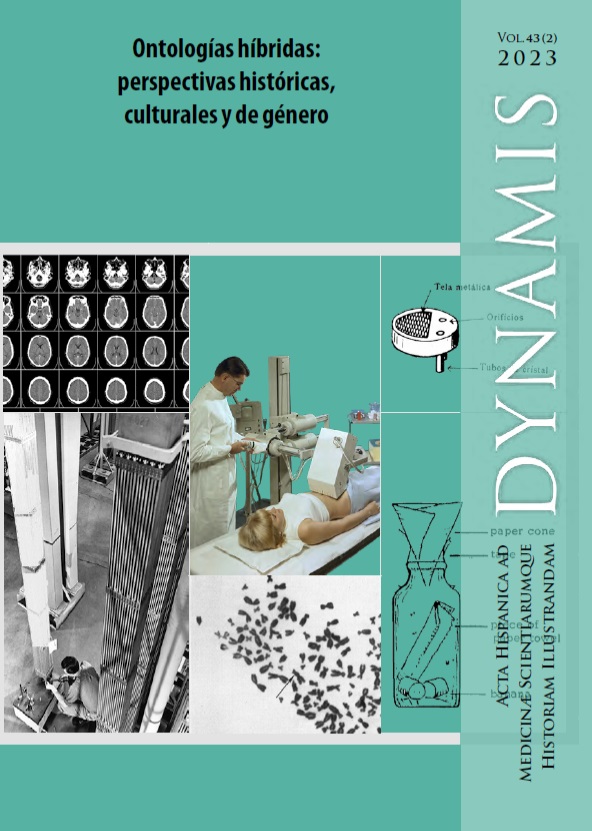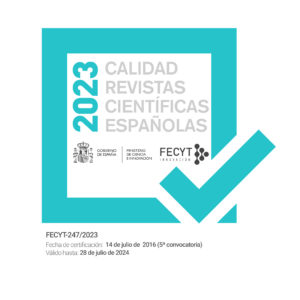A hybrid ontology of gender: chromosomes, photographs, and ultrasound scans in the circulation of fetal imagery in Spain, 1950-1970
DOI:
https://doi.org/10.30827/dynamis.v43i2.29445Keywords:
Fetal historiography, human cytogenetics, medicalization, pregnancy, visual cultures, woman’s bodiesAbstract
This article presents a proposal for a chronology of fetal images in Spain that includes the process of production and circulation of human chromosomes (fetal karyotype as a portrait), of the photographs of fetuses by Lennart Nilsson, and of the images provided by ultrasound scanning. This set of representations made the visual culture of the fetus a gendered historical subject that medicalized and technified pregnancy, privileging the fetus instead of the woman’s pregnant body as the subject of pregnancy. In this process, the fetus gained autonomy as a hybrid ontology. This article contributes to a fetal historiography that analyzes the fetus as manufactured by the interaction of three technologies: cytology, photography, and ultrasound scanning.
Downloads
References
“El secreto de la vida antes de nacer. Por primera vez una criatura es fotografiada en el seno materno”. Gaceta Ilustrada, n.º 500, 7 de mayo de 1965, pp. 43-59.
Bock von Wülfingen, Bettina, Christina Brandt, Susanne Lettow, y Florence Vienne. “Temporalities of reproduction: practices and concepts from the eighteenth to the early twenty-first century”. History and Philosophy of the Life Sciences 37, n.1 (2015): 1-16. DOI: https://doi.org/10.1007/s40656-015-0059-9
Cowan, Ruth Schwartz. “Medicine, Technology and Gender in the History of Prenatal Diagnosis”. En Feminism in Twentieth-century Science, Technology and Medicine, editado por Angela N.H. Creager, Elizabeth Lunbeck and Londa Schiebinger, 186-196 (Chicago: the University of Chicago Press, 2001).
de Blas, Andrés. “El libro y la censura durante el franquismo: un estado de la cuestión y otras consideraciones.” Espacio Tiempo y Forma. Serie V, Historia Contemporánea 12 (1999): 281-301. DOI: https://doi.org/10.5944/etfv.12.1999.2967
de Chadarevian, Soraya. “Chromosome photography and the human karyotype”. Historical Studies in the Natural Sciences 45 n.1 (2014): 115-146. DOI: https://doi.org/10.1525/hsns.2015.45.1.115
de Chadarevian, Soraya. Heredity under the Microscope. Chicago: University of Chicago Press, 2020. DOI: https://doi.org/10.7208/chicago/9780226685250.001.0001
de Grazia, Victoria. How fascism ruled women: Italy, 1922-1945. Berkeley: University of California Press, 1992. DOI: https://doi.org/10.1525/9780520911383
Duden, Barbara. Disembodying Women: Perspectives on Pregnancy and the Unborn, trans. by Lee Hoinacki. Cambridge, MA: Harvard University Press, 1993.
Fontes I. y M. Á. Menéndez. El parlamento de papel. Las revistas españolas en la transición
democrática. Madrid: Anaya-Asociación de la Prensa. 2004.
Franklin, Sarah. “Fetal Fascinations: New Dimensions to the Medical-Scientific Construction of Fetal Personhood”. En Off-Centre: Feminism and Cultural Studies, editado por Sarah Franklin, Celia Lury and Jackie Stacey, 190-205 (London: HarperCollins Academic, 1991).
Gilbert, Scott F. and Rebecca Howes-Mischel. “ ‘Show me your original face before you were born’: The convergence of public fetuses and sacred DNA.” History and Philosophy of the Life Sciences 26 (2004): 377-479.
Hanson, Clare. A Cultural History of Pregnancy: pregnancy, medicine and culture, 1750-2000. Londres: Palgrave 2004. DOI: https://doi.org/10.1057/9780230510548
Hogan, Andrew J. Life histories of Genetic Disease: Patterns and prevention in postwar medical genetics. Baltimore: Johns Hopkins University Press, 2016. DOI: https://doi.org/10.1353/book.48168
Hsu, Tao Chiuh. Human and Mammalian Cytogenetics: An Historical Perspective. New York: Springer-Verlag, 1979. DOI: https://doi.org/10.1007/978-1-4612-6159-9
Ignaciuk, Agata, y Teresa Ortiz-Gómez, Anticoncepción, mujeres y género. La “píldora” en España y Polonia (1960-1980). Madrid: La Catarata, 2016.
Ignaciuk, Agata. “In Sickness and in Health: Expert Discussions on Abortion Indications, Risks, and Patient-Doctor Relationships in Postwar Poland.” Bulletin of the History of Medicine 95, n. 1 (2021): 83-112. DOI: https://doi.org/10.1353/bhm.2021.0003
Ignaciuk, Agata, and Christabelle Sethna. “Charters for Choice: Abortion Travel, Abortion Referral Networks and Spanish Women’s Transnational Reproductive Agency, 1975-1985.” Gender & History 32, n. 2 (2020): 286-303. DOI: https://doi.org/10.1111/1468-0424.12463
Jülich, Solveig “Picturing abortion opposition in Sweden: Lennart Nilsson’s early Photographs of embryos and fetuses.” Social history of medicine 31, n. 2 (2018): 278-307. DOI: https://doi.org/10.1093/shm/hkv114
Jülich, Solveig. “The making of a best-selling book on reproduction: Lennart Nilsson’s A Child Is Born”, Bulletin of the History of Medicine 89 n. 3 (2015): 491-526. DOI: https://doi.org/10.1353/bhm.2015.0091
Jülich, Solveig. “The Drama of Life before birth”. En Reproduction: antiquity to the present day, edited by Nick Hopwood, Rebeca Fleming y Loren Kassell. Cambridge: Cambridge University Press, 2018. DOI: https://doi.org/10.1017/9781107705647.086
Kay, Lily E. “Life as technology: Representing, Intervening, Molecularizing.” In The Biology and History of Molecular Biology: New Perspectives, edited by Sahotra Sarkar, 87-100. Dordrecht: Kluwer, 1996. DOI: https://doi.org/10.1007/978-0-585-31233-0_6
Kottler, Malcolm J. “From 48 to 46: Cytological technique, preconception, and the counting of human chromosomes.” Bulletin of the History of Medicine 48, n. 4 (1974): 465-502.
Lautre, María Jesús. “Predicción antenatal de las anomalías cromosómicas.” En Problemas actuales de genética humana, editado por J. Botella Llusiá y L. Izquierdo Góngora, 177-191. Madrid: Instituto de España, 1976.
Lindee, M. Susan. Moments of truth in genetic medicine. Baltimore: Johns Hopkins University Press, 2008. DOI: https://doi.org/10.1353/book.3463
Löwy, Ilana. Imperfect pregnancies: A history of birth defects and prenatal diagnosis. Baltimore: John Hopkins University Press, 2017. DOI: https://doi.org/10.1353/book.55867
Manifiesto de Madrid 2009- Bioetica en la Red: Principios de la bioética y otras cuestiones. https://www.bioeticaweb.com/manifiesto-de-madrid/.
Martin, Aryn. “Can’t any body count? Counting as an epistemic theme in the history of human chromosomes.” Social Studies of Science 34, n. 6 (2004): 923-948. DOI: https://doi.org/10.1177/0306312704046843
Miguel Sáez de Ureabain, Ainara. “Gaceta Ilustrada y Actualidad Española ¿dos estilos de vida?”. Signa 29 (2020): 171-190. DOI: https://doi.org/10.5944/signa.vol29.2020.27196
Morcillo Gómez, Aurora, En cuerpo y alma. Ser mujer en tiempos de Franco. Madrid: Siglo XXI, 2015.
Morcillo Gómez, Aurora. The Seduction of Modern Spain: The Female Body and the Francoist Body Politic. Lewisburg, Pennsylvania: Bucknell University Press, 2010.
Morgan, Lynn M. Icons of Life: A Cultural History of Human Embryos. Berkeley: University of California Press, 2009. DOI: https://doi.org/10.1525/9780520944725
Hopwood, Nick. Haeckel’s Embryos: Images, Evolution and Fraud. Chicago: University of Chicago Press, 2015. DOI: https://doi.org/10.7208/chicago/9780226047133.001.0001
Nicolson, Malcolm, and John E.E. Fleming. Imaging and imagining the fetus: the development of obstetric ultrasound. Baltimore: Johns Hopkins University Press, 2013. DOI: https://doi.org/10.1353/book.21079
Oakley, Ann. The Captured Womb: A History of the Medical Care of Pregnant Women. Oxford: Basil Blackwell, 1984.
Orland, Barbara. “Babys in der Röhre: Wie die Pädiatrie in den 1980er-Jahren die Normalisierung
der Magnetresonanztechnik unterstützte”. En Ganz normale Bilder: historische Beiträge zur visuellen Herstellung von Selbstverständlichkeit, eds. David Gugerli and Barbara Orland, 227-250. Zurich: Chronos, 2002.
Orland, Barbara. “Motherhood as scientific innovation.” En Gender in Science and Technology:
Interdisciplinary Approaches, edited by Waltraud Ernst and Ilona Horwath, 129-146. Bielefeld: transcript Verlag, 2013.
Ortiz-Gómez, Teresa y Agata Ignaciuk. “The Fight for Family Planning in Spain during Late Francoism and the Transition to Democracy, 1965-1979.” Journal of Women’s History 30, no. 2 (2018): 38-62. DOI: https://doi.org/10.1353/jowh.2018.0013
Pancino, Claudia, y Jean d’Yvoire. Formato nel segreto: Nascituri e feti fra immagini e imaginartio dal xvi and xx secolo. Roma: Carocci, 2006.
Parache Hernández, Javier, and H. Martínez Hernández, “Diagnóstico mediante ecografía bidimensional en obstetricia y ginecología.” Acta Ginecológica XXI (1970): 727-765.
Petchesky, Rosalind Pollack. “Fetal images: The power of visual culture in the politics of reproduction.” Feminist studies 13 (1987): 263-92. DOI: https://doi.org/10.2307/3177802
Rentetzi, Maria. Seduced by radium: how industry transformed science in the American Marketplace. Pittsburgh: University of Pittsburgh Press, 2022. DOI: https://doi.org/10.2307/j.ctv2zx9qnq
Rodríguez Ocaña, Esteban. “La construcción de la salud infantil. Ciencia, medicina y educación en la transición sanitaria en España.” Historia contemporánea, n. 18 (1999), 19-52.
Rosenfeld, Albert y Lennart Nilsson. “El drama de la vida antes de nacer. Por primera vez una criatura es fotografiada en el seno materno.” Gaceta Ilustrada n. 451 (29 de mayo de 1965), 36-sin paginar.
Santesmases, María Jesús. “ Standard making in cytogenetics: the manufacture, circulation and reproduction of chromosome images.” Journal of History of Science and Technology 14, n.1 (2020): 27-54; https://doi.org/10.2478/host-2020-0004 DOI: https://doi.org/10.2478/host-2020-0004
Santesmases, María Jesús. “Circulating biomedical images: Bodies and chromosomes in the post-eugenic era.” History of Science 55, n. 4 (2017): 395-430. DOI: https://doi.org/10.1177/0073275317701145
Santesmases, María Jesús. “Human Chromosomes and Cancer: Tumors and the Geographies of Cytogenetic Practices, 1951-1956.” Historical Studies in the Natural Sciences 45, n.1 (2014): 85-114. DOI: https://doi.org/10.1525/hsns.2015.45.1.85
Santesmases, María Jesús. “The human autonomous karyotype and the origins of prenatal testing: Children, pregnant women and early Down’s syndrome cytogenetics, 1962-1975.” Studies in History and Philosophy of Biological and Biomedical Sciences 47 (2014): 142-153. DOI: https://doi.org/10.1016/j.shpsc.2014.05.014
Santesmases, María Jesús “Women in early human cytogenetics: An essay on a gendered history of chromosome imaging.” Perspectives on Science 28, n. 2 (2020): 170-200. DOI: https://doi.org/10.1162/posc_a_00337
Santesmases, María Jesús. “The public fetus in Franco’s Spain during the 1960s: Images of pregnancy for women, doctors and feminists”, en Rethinking the Public Fetus: Historical Perspectives on the Visual Culture of Pregnancy, edited by Elisabet Björklund and Solveig Jülich. Rochester, Nueva York: University of Rochester Press, 2024, en prensa. DOI: https://doi.org/10.2307/jj.4331928.11
Santesmases, María Jesús, y Edna Suárez. “A cell-based epistemology: Human genetics in the era of biomedicine. Introduction to a special issue.” Historical Studies in the Natural Sciences 45, n. 1 (2015): 1-13 DOI: https://doi.org/10.1525/hsns.2015.45.1.1
Schoen, Johanna. Abortion After Roe. Chapel Hill: University of North Carolina Press, 2015. DOI: https://doi.org/10.5149/northcarolina/9781469621180.001.0001
Secord, Anne. “Talbot´s first lens: Botanical vision as an exact science.” In William Henry Fox Talbot. Beyond photography, edited by Mirjam Brusius, Katrina Dean, and Chitra Ramalingam, 41-66. New Haven : Yale University Press, 2013.
Sontag, Susan. On Photography. Nueva York: Farrar Straus & Cudahy, 1977. V. cast. Sobre la fotografía, trad. cast. Carlos Gardini. Barcelona: Edhasa, 1981.
Talbot, William Fox. The Pencil of Nature. Longman, Brown, Green and Longmans: Londres 1844. https://www.gutenberg.org/ebooks/33447.
Tansey, E.M., and Daphne Christie, eds. Looking at the unborn: Historical aspects of obstetric ultrasound. London: The Wellcome Trust, 2000.
Tjio, Joe Hin, and Albert Levan. ‘‘The Chromosome Number of Man.” Hereditas 42 (1956): 1-6. DOI: https://doi.org/10.1111/j.1601-5223.1956.tb03010.x
Zenger, Ingo. The History of Ultrasound Imaging at Siemens Healthineers. Erlangen: Siemens Healthcare GmbH, 2018.
Downloads
Published
How to Cite
Issue
Section
License
Copyright (c) 2023 Dynamis

This work is licensed under a Creative Commons Attribution-NonCommercial-NoDerivatives 4.0 International License.
Dynamis se encuentra adherida a una licencia Creative Commons Reconocimiento (by), la cual permite cualquier explotación de la obra, incluyendo una finalidad comercial, así como la creación de obras derivadas, la distribución de las cuales también está permitida sin ninguna restricción.

















